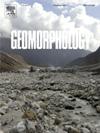Cave sediment chronology and erosion rates in the São Desidério karst reveal a million-year-scale landscape evolution of the Central Brazilian Plateau
IF 3.1
2区 地球科学
Q2 GEOGRAPHY, PHYSICAL
引用次数: 0
Abstract
In central Brazil, regional-scale plateaus and ridges have developed during the Cenozoic in cratonic terrains, after the continental breakup of Pangea. The timing and mechanisms associated with the uplift of such landscape features are poorly understood due to the scarcity of data concerning crustal dynamics and erosion rates. This study used limestone caves containing a rich sedimentary record to obtain new erosion and fluvial incision rate data from the last 3 Ma in the Central Brazilian Plateau. The combination of different geochronological methods (cosmogenic 26Al and 10Be, OSL, and U![]() Th series), cave passage leveling, and geophysical soundings allowed for the reconstruction of the valley incision history of the São Desidério River since the Late Pliocene. Knickpoint migration rates in the limestone towards the sandstone contact varied from 3782 ± 984 and 1122 ± 198 m/Ma in the São Desidério River and a major tributary. An expressive base level drop of 30–50 m has occurred between 1 and 2 Ma from present and is evidenced by distinct cave levels and the entrenchment of vadose canyons. The average fluvial incision rate in the limestone was determined as 52.5 ± 13.0 m/Ma. The average fluvial incision rate associated with the removal of sediment infill from the conduits was determined as 657.0 ± 31.0 m/Ma. The average erosion rate in the plateau's sandstone-covered catchment areas was 17.1 ± 1.4 m/Ma. Knickpoint retreat and valley incision rates suggest that the onset of the limestone exposure and prominent karst landscape development occurred during the Late Pliocene.
Th series), cave passage leveling, and geophysical soundings allowed for the reconstruction of the valley incision history of the São Desidério River since the Late Pliocene. Knickpoint migration rates in the limestone towards the sandstone contact varied from 3782 ± 984 and 1122 ± 198 m/Ma in the São Desidério River and a major tributary. An expressive base level drop of 30–50 m has occurred between 1 and 2 Ma from present and is evidenced by distinct cave levels and the entrenchment of vadose canyons. The average fluvial incision rate in the limestone was determined as 52.5 ± 13.0 m/Ma. The average fluvial incision rate associated with the removal of sediment infill from the conduits was determined as 657.0 ± 31.0 m/Ma. The average erosion rate in the plateau's sandstone-covered catchment areas was 17.1 ± 1.4 m/Ma. Knickpoint retreat and valley incision rates suggest that the onset of the limestone exposure and prominent karst landscape development occurred during the Late Pliocene.
在巴西中部,在盘古大陆分裂后的新生代,在克拉通地形中发育了区域尺度的高原和山脊。由于缺乏有关地壳动力学和侵蚀速率的数据,人们对与这些景观特征隆起有关的时间和机制知之甚少。本研究利用含有丰富沉积记录的石灰岩洞穴,获得了巴西中部高原近3 Ma以来新的侵蚀和河流切割速率数据。结合不同的地质年代学方法(宇宙成因26Al和10Be、OSL和UTh系列)、洞穴通道平整和地球物理测深,重建了晚上新世以来s o desidsamrio河的河谷切割历史。在德西达姆河及其主要支流中,灰岩向砂岩接触层的尼克点迁移速率分别为3782±984和1122±198 m/Ma。在距今1 ~ 2 Ma之间发生了一次明显的基准面下降30 ~ 50 m,这可以从明显的洞穴水平和渗透峡谷的壕沟中得到证明。石灰岩中河流的平均切割速率为52.5±13.0 m/Ma。与管道中沉积物填充物去除相关的平均河流切割速率确定为657.0±31.0 m/Ma。高原砂岩覆盖集水区的平均侵蚀速率为17.1±1.4 m/Ma。尼克点后退和山谷切割速率表明,晚上新世开始了石灰岩暴露和岩溶景观的突出发育。
本文章由计算机程序翻译,如有差异,请以英文原文为准。
求助全文
约1分钟内获得全文
求助全文
来源期刊

Geomorphology
地学-地球科学综合
CiteScore
8.00
自引率
10.30%
发文量
309
审稿时长
3.4 months
期刊介绍:
Our journal''s scope includes geomorphic themes of: tectonics and regional structure; glacial processes and landforms; fluvial sequences, Quaternary environmental change and dating; fluvial processes and landforms; mass movement, slopes and periglacial processes; hillslopes and soil erosion; weathering, karst and soils; aeolian processes and landforms, coastal dunes and arid environments; coastal and marine processes, estuaries and lakes; modelling, theoretical and quantitative geomorphology; DEM, GIS and remote sensing methods and applications; hazards, applied and planetary geomorphology; and volcanics.
 求助内容:
求助内容: 应助结果提醒方式:
应助结果提醒方式:


